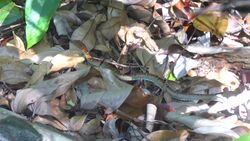Biology:Banded flying snake
| Twin-barred tree snake | |
|---|---|

| |
| Scientific classification | |
| Domain: | Eukaryota |
| Kingdom: | Animalia |
| Phylum: | Chordata |
| Class: | Reptilia |
| Order: | Squamata |
| Suborder: | Serpentes |
| Family: | Colubridae |
| Genus: | Chrysopelea |
| Species: | C. pelias
|
| Binomial name | |
| Chrysopelea pelias | |
The twin-barred tree snake[3] (Chrysopelea pelias) is a species of snake found in Southeast Asia. It is also called the banded flying snake. It can glide, as with all species of its genus Chrysopelea, by stretching the body into a flattened strip using its ribs. It is mostly found in moist forests and can cover a horizontal distance of about 100 metres in a glide from the top of a tree. It is an oviparous snake.
Chrysopelea pelias has an overlapping range with the paradise tree snake (Chrysopelea paradisi) in Malaysia, Singapore, Borneo and Indonesia. However, Chrysopelea pelias is not nearly as common as the paradise tree snake.[4]
Distribution
The twin-barred tree snake is found in Thailand, Malaysia (Malaya, Penang Island, Pulau Tioman, and East Malaysia), Indonesia (Bangka, Java, Mentawai Archipelago, Pulau Hinako (sv), Natuna Archipelago, Nias, Riau Archipelago, Sumatra, Borneo); Brunei Darussalam; Burma ;India, Western Ghats Singapore.[2]
References
- ↑ Grismer, L., Auliya, M. & Chan-Ard, T. (2012) Chrysopelea pelias. In: IUCN 2012. IUCN Red List of Threatened Species. Version 2012.2.
- ↑ 2.0 2.1 Chrysopelea pelias (LINNAEUS, 1758). Reptile-database.reptarium.cz. Retrieved on 2013-01-03.
- ↑ Species List. Ecology Asia. Retrieved on 2013-01-03.
- ↑ Twin Barred Tree Snake Naturemalaysia.com
Further reading
- Boie, F. 1827 Bemerkungen über Merrem's Versuch eines Systems der Amphibien, 1. Lieferung: Ophidier. Isis van Oken, Jena, 20: 508–566.
- Auliya, M. 2006. Taxonomy, Life History, and conservation of giant reptiles in west Kalimantan. Natur und Tier Verlag, Münster, 432 pp.
- Chan-ard,T.; Grossmann,W.; Gumprecht,A. & Schulz,K. D. 1999. Amphibians and reptiles of peninsular Malaysia and Thailand – an illustrated checklist [bilingual English and German]. Bushmaster Publications, Würselen, Germany, 240 pp.
- David,P. & Vogel,G. 1996. The snakes of Sumatra. An annotated checklist and key with natural history notes. Bücher Kreth, Frankfurt/M.
- Hien,P. Grossmann,W. & Schäfer, C. 2001. Beitrag zur Kenntnis der landbewohnenden Reptilienfauna von Pulau Tioman, West-Malaysia. Sauria 23 (4): 11–28
- Lim, K.K.P. & Ng, H.H. 1999. The terrestrial herpetofauna of Pulau Tioman, Peninsular Malaysia. Raffles Bull. Zool., Suppl. No. 6: 131–155
- Linnaeus, C. 1758. Systema naturæ per regna tria naturæ, secundum classes, ordines, genera, species, cum characteribus, differentiis, synonymis, locis. Tomus I. Editio decima, reformata. Laurentii Salvii, Holmiæ. 10th Edition: 824 pp.
- Malkmus, R.; Manthey, U.; Vogel, G. Hoffmann, P. & Kosuch, J. 2002. Amphibians and reptiles of Mount Kinabalu (North Borneo). A.R.G. Ganther Verlag, Rugell, 404 pp.
- Malkmus,R. 1985. Amphibien und Reptilien vom Mount Kinabalu (4101 m), Nordborneo. Herpetofauna 7 (35): 6–13
- Manthey, U. & Grossmann, W. 1997. Amphibien & Reptilien Südostasiens. Natur und Tier Verlag (Münster), 512 pp.
- Teo, R.C.H. & Rajathurai, S. 1997. Mammals, reptiles and amphibians in the Nature Reserves of Singapore – diversity, abundance and distribution. Proc. Nature Reserves Survey Seminar. Gardens’ Bulletin Singapore 49: 353–425
Wikidata ☰ Q2383428 entry


